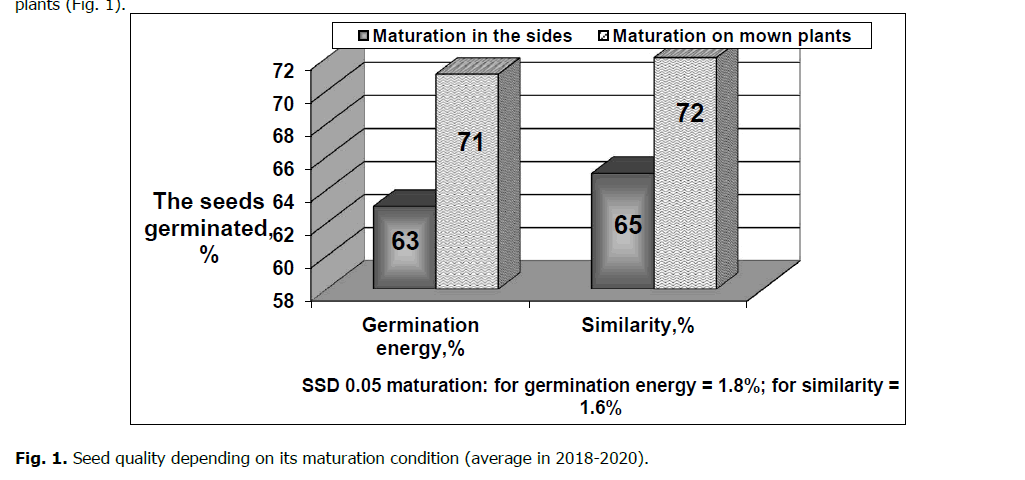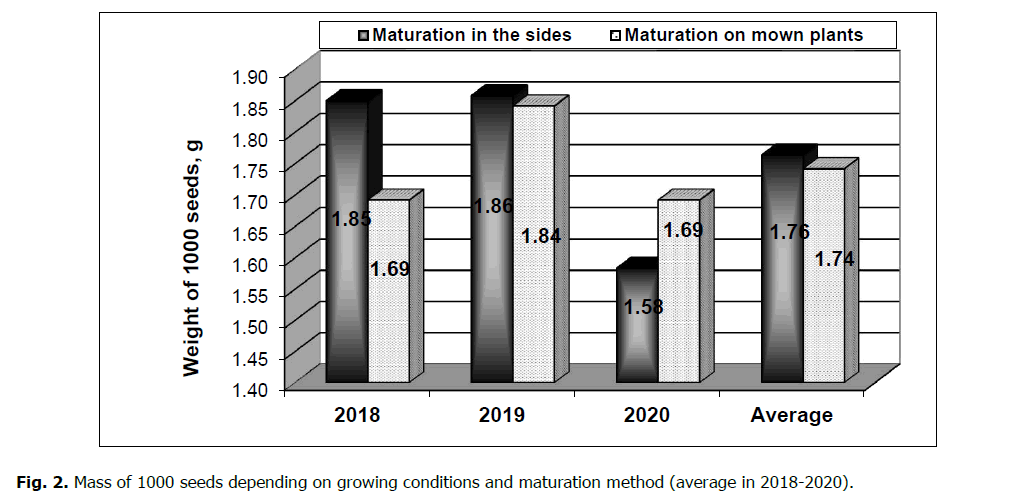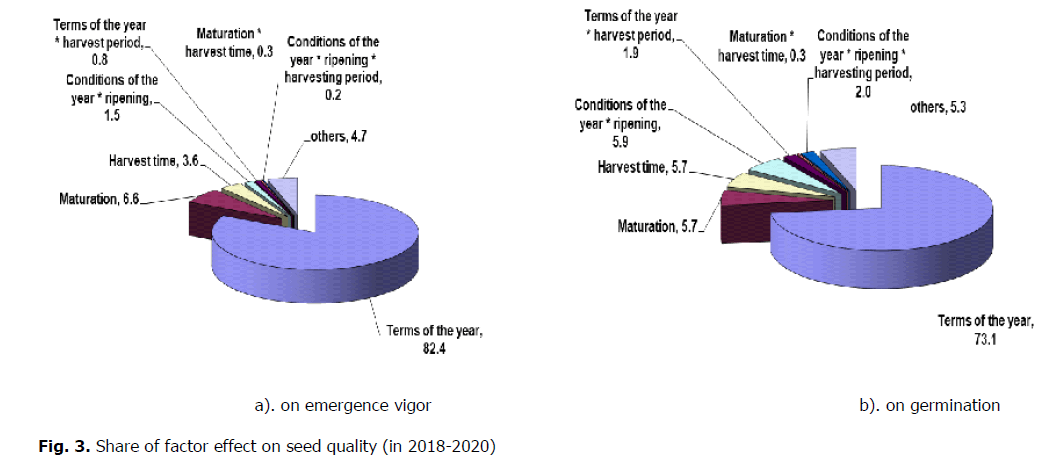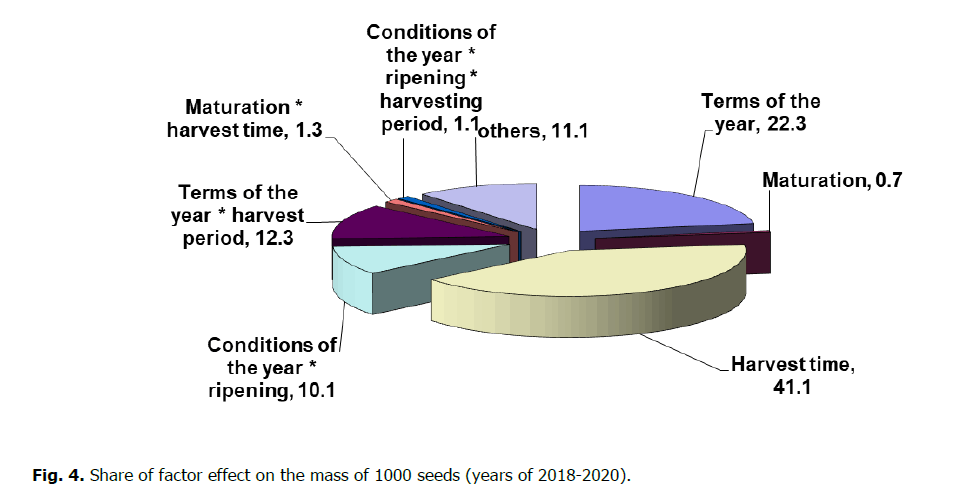Research Article - (2021) Volume 11, Issue 3
Influence of harvesting terms on the quality of switchgrass seeds
V.V. Dryha1, V.A. Doronin1, V.M. Sinchenko1, Yu.A. Kravchenko1, H.S. Honcharuk1, N.S. Zatserkovna1, L.M. Karpuk2* and V.P. Mykolaiko3Abstract
The paper covers some specific aspects of the quality formation of switch-grass seeds depending on growing conditions and harvesting terms. Methods. Field, laboratory, and statistics. To find out how emergence vigor and seed germination change under the effect of a seed maturation method, seed samples threshed after mowing (direct combining) and seed samples after drying and maturation on the mown plants (a particular harvesting method) were taken. Results. We found that switch-grass seed germination depended on post-harvest maturation on the mown plants. On average, within three years, emergence vigor and seed germination were significantly higher at seed maturation on the mown plants – by 8% and by 7%, respectively. The quality improvement of the seeds matured on the mown plants results from the outflow of the nutrient substances from plants to seeds, which is not the case when seeds threshed after the plants were mown mature in piles. The mass of 1000 seeds did not change significantly depending on a seed maturation method; at seed maturation on the mown plants, it was 1.74 g; at seed maturation in piles, it was 1.76 g. When seeds were harvested at 50% of panicle browning, regardless of a maturation method, emergence vigor and germination were the lowest – 61-66% and 63-67%, respectively. When seeds were harvested at 100% of panicle browning, the indicators were significantly higher than at an earlier harvesting term, emergence vigor and germination increased by 6 and 9%, respectively, the mass of 1000 seeds increased by 0.08-0.25 g. When seed harvesting was at 75% of panicle browning, emergence vigor and germination were reliably higher than at 50% of panicle browning, and they were much lower when seed harvesting was done at 100% of panicle browning. Conclusions. Germination of switch-grass seeds depended on both harvesting terms and post-harvest maturation on the mown plants. Hence, one way to improve seed quality is to apply a particular harvesting method: mowing plants in swathes, seed drying and maturation on the mown plants, and threshing.
Keywords
harvesting terms, switchgrass, maturation, panicle browning, emergence vigor, germination, the mass of 1000 seeds.
Introduction
Problem definition
Ukraine belongs to energy-depending countries on traditional kinds of fuel – oil products and natural gas, which decreases annually and the price of them rises. So, the search and production of alternative sources of energy are urgent for the country, the ones which can reduce the country’s dependence on traditional kinds of fuel (Doronin, 2018), with the minimal effect on the environment and the less possible technogenic catastrophe (Gorba, 2017).
The most promising part of bioenergetics is the use of plant origin biomass – phytoenergetics. The following crops present a beneficial interest for the production of bio-fuel from biomass: sugar beets, switch-grass, sugar sorghum, miscanthus (Mozharivska, 2013; Monti, 2009; Mitchell, 2012), willow, and poplar (Fuchilo, 2009; Wullschleger, 2010; Vogel, 2011). Energy plants are valuable due to good yields and flexibility in growing conditions (Withers, 2010). Among the promising energy plants of a grain crop family introduced in Ukraine, special attention has to be paid to a perennial grain crop – switchgrass (Panicum virgatum L.), which can accumulate a considerable amount of biomass due to photosynthesis. However, the main limiting factors in introducing switch-grass into production are its low seed germination, which is explained by biological properties of varieties, and a long seed dormancy period, resulting in low field germination uneven emergence. It is a known fact that seed germination depends on both biological peculiarities of a crop and weather and farm practices and a pre-sowing preparation. One of the essential farm practices is the terms of seed harvesting.
A proper determination of seed harvesting terms is of great significance as they influence yield capacity and quality. Switch-grass seeds are prone to shed after maturation, so it is required to determine an optimal term and a harvesting method. The mowing of seed plants at too early or too late terms worsens sowing seed qualities and decreases its yield capacity. According to Kristek and Matic (1984), when harvested at early terms, seed germination decreased by 10%, at later terms, seed yield decreased by 35%; according to Korniienko (1980), when harvested at early terms, seed germination decreased by 18-33%, as compared with optimal terms, and at last terms of harvesting – by 6-8%. When seed plants were harvested at early terms, emergence vigor and seed germination decreased by 5%, directly related to field germination (Nosalsky, 1992).
It is possible to determine harvesting terms of seed plants by morphological features, in days from the beginning of flowering of seed plants (Dobrotvortseva, 1962; Fedorov, 1966), by the indicators of fruit browning, the softness of seed perisperm, and its humidity (Kornienko, 1980), by chlorophyll content in the seed coat which is defined by activating it with X-rays (Jalink, 1999), and by the sum of active temperatures during harvesting. Thus, the higher the sum of temperatures, the higher yield capacity and seed germination (Sekimura, 1986).
Switch-grass seeds have a high dormancy period, particularly after harvesting (Elbersen, 2001). According to Kulyk et al. (2013), switch-grass seeds, right after harvesting, are characterized by a high dormancy state. Harvesting at optimal terms and creating the conditions for efficient post-harvesting maturation ensure high seed germination. One of the indicators taken into consideration when harvesting terms are determined is seed coat or panicle browning . According to Johnа J. Brejda et al. (1994), an optimal harvesting term for switch-grass seeds in the conditions of the USA was the term when seeds began to shed from panicle tops, and seeds were firm and brown on the lower panicle branches. In the conditions of unstable humidity of the Forest-steppe zone of Ukraine, harvesting terms of switch-grass seeds have not been studied till these days; this has become the purpose of our research.
Materials and Methods
The research program envisages studying some specific aspects of the formation of switchgrass seed quality depending on growing conditions and seed harvesting terms. The research was carried out at the Institute of bioenergy Crop and Sugar Beets of NAAS and in the conditions of unstable humidity at the Yaltushkivska Research-Selection Station in 2018 2020. A trial scheme implies seed harvesting at three terms – 50, 75, 100% of panicle browning, seed maturation and drying on the mown plants (a particular harvesting method), and maturation and drying threshed seeds right after plant mowing (a direct harvesting method). The trial is based on the hypothesis that nutrient substances move from plants to seeds when they are drying on еру mown plants, which may increase the emergence intensity. A ten-time replication is used (ten plants of each variant and replications). The statistical processing of the experimental data was done with the help of dispersion and correlation analyses by Fisher’s method (Fisher, 2006) using Statistica 6.0 software. The trials were carried out on low-productive, grey opodzolic, poorly washed-away soils with low humus content, namely 1.56%. The content of labile phosphorus forms and exchange potassium (by Chyrykov) was 170 and 132 mg/kg, respectively; the content of easily-hydrolyzed nitrogen (by Cornfield) was 59 mg/kg of the soil. The weather conditions in the years of the research were similar to those typical for this zone. The average daily air temperature was 15.5-16.5 °С, and it was higher by 2.0-3.0 °С as compared with a long-term indicator. As to humidity, the years of 2018 and 2020 were dry; moisture deficit was 97.0 and 47.7 mm, and the year of 2019 was characterized with excessive humidity, a precipitation amount was higher than a long-term indicator by 38 mm.
Results
To find out how emergence vigor and seed germination change under the effect of a seed maturation method, seed samples threshed after mowing (direct combining) and seed samples after drying and maturation on the mown plants (a particular harvesting method) were taken. We found that switch-grass seed germination depended on post-harvest maturation on the mown plants (Fig. 1).

Figure 1: Seed quality depending on its maturation condition (average in 2018-2020).
On average, within three years, emergence vigor and seed germination were significantly higher at seed maturation on the mown plants – by 8% (SSD0.05 maturation =1.8%) and by 7% (SSD0.05 = 1.6%), respectively. The quality improvement of the seeds matured on the mown plants results from the outflow of the nutrient substances from plants to seeds, which is not the case when seeds threshed after the plants were mown mature in piles. Hence, one way to improve seed quality is to apply a particular harvesting method: mowing plants in swathes, seed drying and maturation on the mown plants, and threshing. Maturation conditions had a severe effect at an early harvesting term and 50% of panicle browning. Seed threshing from the plants after they were mown and seed drying beyond plants led to a significant reduction of emergence vigor and seed germination compared with seed threshing after their maturation and drying.
It was established that the mass of 1000 seeds did not change considerably depending on the method of seed maturation on average within three years of the research. On average, in the years of the research, when seeds matured on the mown plants, the mass of 1000 seeds was 1.74 g, in piles – 1.76 g (SSD0.05 maturation= 0.03 g). During the research, a regular increase in 1000 seeds mass, depending on its maturation on the mown plants, was not recorded (Fig. 2).

Figure 2: Mass of 1000 seeds depending on growing conditions and maturation method (average in 2018-2020).
We registered that harvesting terms had a significant effect on the quality of witch-grass seeds (Table 1).
Table 1. Quality of switch-grass seeds depending on harvesting terms and post-harvest maturation (Yaltushkivska RSS, average in 2018-2020).
| Variant | Emergence vigor, % | Germination, % | Mass of 1000 seeds, g | |
|---|---|---|---|---|
| Threshing term | Seed harvesting at plant browning, % | |||
| Right after mowing | 50 | 61 | 63 | 1.61 |
| 75 | 63 | 67 | 1.83 | |
| 100 | 67 | 69 | 1.86 | |
| After maturation on mown plants | 50 | 66 | 67 | 1.78 |
| 75 | 72 | 72 | 1.80 | |
| 100 | 75 | 76 | 1.86 | |
| SSD0.05 tot. | 4.5 | 4.8 | 0.10 | |
| SSD0.05 maturation | 1.8 | 1.6 | 0.03 | |
| SSD0.05 harvesting term | 1.8 | 1.2 | 0.04 | |
Despite the maturation method, seed quality was the lowest when seeds were harvested at 50% of panicle browning. On average, within three years, emergence vigor of the seeds threshed after plants were mown was 61%, emergence vigor of those matured on the mown plants was 66%, and germination vigor was 63 and 67%, and the mass of 1000 seeds – 1.61 and 1.78 g, respectively.
When seeds were harvested at 100% of panicle browning, these indicators were significantly higher than at an earlier harvesting term, emergence vigor and germination increased by 6 and 9%, respectively, the mass of 1000 seeds increased by 0.08-0.25 g (SSD0.05 harvesting terms = 0.04 g). The mass of 1000 seeds changed significantly depending on seed harvesting terms. On average, during the years of the research, when seeds were harvested at 50% of panicle browning and matured in piles, the mass of 1000 seeds was the lowest – 1.61 g, whereas it was 1.83 g (higher by 0.22 g) when seeds were harvested at 75% of panicle browning; at 100% of panicle browning these indicators were 0.25 and 1.86 g, respectively. A similar correlation was recorded at seed maturation and drying on the mown plants, but the difference depending on harvesting terms was lower.
Similar results concerning seed quality were received by the years of the research. The reliable lowest emergence vigor and seed germination were recorded when seeds were harvested at 50% of panicle browning; these indicators were the highest at 100% of panicle browning, regardless of a seed maturation state (Table 2).
Table 2. Seed quality depending on harvesting term (Yaltushkivska RSS, in 2018-2020).
| Variant | Emergence vigor, % | Germination, % | Mass of 1000 seeds, g | ||
|---|---|---|---|---|---|
| Harvest year | Threshing term | Harvesting term at panicle browning, % | |||
| 2018 | Threshed after mowing | 50 | 72 | 72 | 1.53 |
| 75 | 78 | 78 | 1.98 | ||
| 100 | 82 | 82 | 2.05 | ||
| On the plants after mowing | 50 | 73 | 73 | 1.45 | |
| 75 | 82 | 82 | 1.80 | ||
| 100 | 82 | 82 | 1.83 | ||
| 2019 | Threshed after mowing | 50 | 46 | 51 | 1.80 |
| 75 | 47 | 52 | 1.85 | ||
| 100 | 50 | 54 | 1.93 | ||
| On the plants after mowing | 50 | 50 | 52 | 1.73 | |
| 75 | 56 | 56 | 1.85 | ||
| 100 | 54 | 55 | 1.95 | ||
| 2020 | Threshed after mowing | 50 | 64 | 64 | 1.50 |
| 75 | 67 | 67 | 1.65 | ||
| 100 | 65 | 68 | 1.60 | ||
| On the plants after mowing | 50 | 74 | 75 | 1.53 | |
| 75 | 77 | 77 | 1.75 | ||
| 100 | 91 | 92 | 1.80 | ||
| SSD 0.05 tot. | 4.5 | 4.8 | 0.10 | ||
| SSD 0.05 year conditions | 2.2 | 2.0 | 0.04 | ||
| SSD 0.05 threshing term | 1.8 | 1.6 | 0.03 | ||
| SSD 0.05 harvesting term | 1.8 | 2.0 | 0.04 | ||
Regardless of a harvesting term, reliably higher indicators of seed quality were received in 2018, which was caused by weather conditions during vegetation, particularly in the phase of flowering and seed formation. The period of flowering, the third decade of July – the first and the second decades of August, was favorable for pollination and fertilization: an average daily air temperature was higher by 3.2 and 1.5 °С, and a slight precipitation deficit was 7.9 and 14.8 mm, respectively. September, the period of seed formation, was warm and dry; in the first and the second decades, an average daily air temperature was 17.6 and 17.1 °С, and during a month, it exceeded a long-term indicator by 1.8 °С with moisture deficit equal to 11.6 mm. Precipitations were distributed evenly by decades. October, a period of seed harvesting, was typical for this area.
In 2019 and 2020, the phases of flowering and seed formation took place in less favorable conditions than in 2018, which impacted seed quality. In 2019 and 2020, the phases of flowering and seed formation were similar to the long-term average by the temperature condition, and by the humidity condition, they were dry and characterized with a moisture deficit. In 2019 a moisture deficit was 55 mm, and in 2020 it was 105 mm. In 2019 the period of seed harvesting (October) was favorable, with almost no precipitation – only 9 mm (a long-term indicator is 30 mm); and on the contrary, the 2020 was characterized with excessive humidity, the precipitation amount was 91 mm (a long-term indicator is 30 mm), besides 75% of precipitation was in the first decade of October – the period of seed harvesting.
In 2018, when seeds were harvested and threshed after the plants were mown at 50% of panicle browning, emergence vigor and germination were higher by 26 and 21% compared with 2019 and by 8% compared to 2020. In all the years when the research was carried out, the indicators of a seed quality – emergence vigor, germination, and the mass of 1000 seeds – were significantly higher at maturation and drying on the mown plants regardless of a harvesting term.
In the years of the research, growing conditions – the factor “year” – had the highest effect on emergence vigor and germination – 82.4% and 73.1% (Fig.3).

Figure 3: Share of factor effect on seed quality (in 2018-2020)
The effect shares of the factor “a harvesting term” on emergence vigor was 3.6% and that on germination – 5.7%, the effect share of the factor “a threshing-maturation term” was 6.6 and 5.7%, respectively.
Taken separately by the years of the research, in 2018, the effect share of the factor “a harvesting term” was severe, namely, on emergence vigor and germination – 76.5 and 75.2%, respectively, in 2019 – 18.6 and 42.2%, and 2020 – 25.5 and 31.8%.
The effect of the factors on the mass of 1000 seeds was somewhat different. The terms of seed harvesting had the highest effect (41.1%), and the effect of the factor “year conditions” was 22.3% (Fig.4).

Figure 4: Share of factor effect on the mass of 1000 seeds (years of 2018-2020).
The effect of the factor “a threshing-maturation term” was low – 0.7%.
Thus, the seed harvesting terms and the maturation methods had a reliable effect on the quality of switch-grass seeds.
Conclusion
We registered that germination of switch-grass seeds depended on both harvesting terms and post-harvest maturation on the mown plants. One way to improve seed quality is mowing seed plants in swathes at 100% of panicle browning (a particular harvesting method), seed drying and maturation on the mown plants, and threshing. Seed harvesting at 100% of panicle browning ensured a significant increase of emergence vigor, germination, and the mass of 1000 seeds by 6%, 9%, and 0.08-0.25 g, respectively. When seed harvesting was at 75% of panicle browning, emergence vigor and germination were reliably higher than at 50% of panicle browning, and they were much lower when seed harvesting was done at 100% of panicle browning.
References
Doronin V.A., Kravchenko Yu.V., Dryha V.V., Doronin V.V. The formation of miscanthus planting material in the second year of vegetation depending on the elements of its cultivation technology. Bioenergetics. 2018. № 2(12). P.28−31.
The development and improvement of the energy systems consider the available potential of the alternative energy sources: a collective monograph. (2017). O.O. Horb, T.O. Chaika, I.O. Yasneliub (Eds.). Poltava: “Ukrpromtorhservis” Ltd.
Mozharivska I.A. The cultivation technology of rare energy crops for the production of various kinds of bio-fuel. Proceedings of the Institute of bio-energy crops and sugar beets: proceed. Kyiv, 2013. Iss. 19. 85 p.
Monti A, Fazio S, Venturi G (2009) The discrepancy between plot and field yields: Harvest and storage losses of switchgrass. Biomass Bioenerg 33:841–847.
Mitchell RB, Vogel KP, Uden DR (2012) The feasibility of switchgrass for biofuel production. Biofuels 3:47–59.
Fuchylo Ya.D., Sbytna M.V., Furchylo О.Ya., Litvin V.М. The experience and perspective of poplar growing (Populus sp.l.) in the southern steppe of Ukraine. Proceedings of Forest academy of sciences of Ukraine: proceed. 2009. Iss. 7. P.66–69.
Wullschleger SD, Davis EB, Borsuk ME, Gunderson CA, Lynd LR (2010) Biomass production in switchgrass across the United States: database description and determinants of yield. Crop Sci 102:1158–1168.
Vogel KP, Sarath G, Saathoff A, Mitchell R (2011) Switchgrass. In: Halford N, Karp A (eds) Energy Crops. The Royal Society of Chemistry, Cambridge.
Withers, K. 2010. Establishment fertility and harvest management for optimizing switchgrass yield and quality as a cellulosic ethanol feedstock in the great lakes region. M.S.Thesis. Michigan State University.
Kristek A., Matic J. Utreeoj gostace usjeve i termina zetve na prinosi kvalitet sjemena secerne repe. Agronomiski glassing (Zogreb). 1984.-g.46. 6r 3.4. S. 259-269.
Kornienko V.L. Optimal terms of seed plant harvesting. Sugar beet. 1980. № 6. P. 34.
Nosalskiy V.V., Ostrovskiy L.L., Doronin V.A. Harvesting terms of MS hybrids. Sugar beet. 1992. № 3. P. 43–45.
Dobrotvortseva A.V. Harvesting and threshing of sugar beets grown for seeds. M.:Ed. Agricultural literature, 1962. P.125–132.
Fedorov О.І., Snihur H.P. Hybrid seeds and yield. – K.:Association “Znannia”, 1966. P.37.
H.Jalink, R.von der Sehoor, I.E.Birnbaum and R.J.Bino Seed chlorophyll content as an indicator for seed maturity and seed quality. Proc.of the int.Symp. Stand Establishment. Seed Eds.Liptay,Vavzing,Wellaum Acta Hort. 1999. ISHS. P.504.
Sekimura K., Nachinohe M., Takeda J., Hagehewa T. Studies on seed production of sugar beet, Relationship between harvesting time and seed yield and seed germination rate. Proc.Sugar Beet Res antue. 1986. №27. P.69–73.
Elbersen H.W., Christian D.G., Bassen N. El. еt al. Switchgrass variety choice in Europe. Aspects of Applied Biology. 2001. № 65. P. 21–28.
Kulyk М., Riy О., Kraisvitniy P. Productivity of millet seeds (Panicum virgatumL.) of the second year of vegetation. Bulletin of Lviv national agrarian university. Ser: Agronomy. 2013. Iss. 17(2). P. 215–219.
Management of switch-grass for forage and seed production John J. Brejda, James R. Brown, Gary W. Wyman, and William K. Schumacher Authors are a senior research specialist, a professor, and a former research specialist, School of Natural Resources, 144 Mumford Hall, University of Missouri, Columbia 65211. J. Range Manage. 4722-27, January 1994.
Fisher R.A. Statistical methods for research workers. New Delhi: Cosmo Publications, 2006. 354 p. Site of StatSoft company, a developer of Statistica 6.0 software: http://www.statsoft.ru/.
Author Info
V.V. Dryha1, V.A. Doronin1, V.M. Sinchenko1, Yu.A. Kravchenko1, H.S. Honcharuk1, N.S. Zatserkovna1, L.M. Karpuk2* and V.P. Mykolaiko32Bila Tserkva National Agrarian University, Bila Tserkva, Kyiv rgn., Ukraine
3Pavlo Tychyna Uman State Pedagogical University, Uman, 20300, Ukraine
Citation: Dryha, V.V., Doronin, V.A., Sinchenko, V.M., Kravchenko, Yu.A., Honcharuk, H.S., Zatserkovna, N.S., Karpuk, L.M., Mykolaiko V.P. (2021). Influence of harvesting terms on the quality of switchgrass seeds. Ukrainian Journal of Ecology, 11 (3), 8-13.
Received: 04-Feb-2021 Accepted: 05-Feb-2021 Published: 05-May-2021, DOI: 10.15421/2021_135
Copyright: This is an open access article distributed under the terms of the Creative Commons Attribution License, which permits unrestricted use, distribution, and reproduction in any medium, provided the original work is properly cited.
